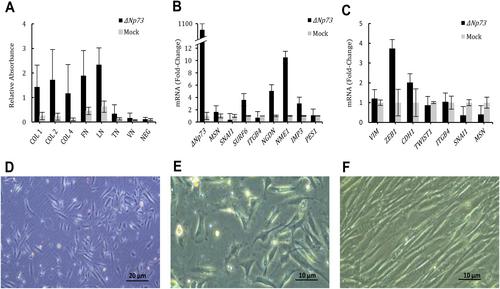ΔNp73 and its effector targets promote colorectal peritoneal carcinosis and predict survival
Daniel Pastor-Morate, Lidia Amigo-Morán, María Garranzo-Asensio, Raquel Rejas-González, Patricia Carnicero, Nuria Rodríguez, Juan Pedro Pérez-Robledo, Rodrigo Barderas, Isabel Prieto-Nieto, Gemma Domínguez
下载PDF
{"title":"ΔNp73 and its effector targets promote colorectal peritoneal carcinosis and predict survival","authors":"Daniel Pastor-Morate, Lidia Amigo-Morán, María Garranzo-Asensio, Raquel Rejas-González, Patricia Carnicero, Nuria Rodríguez, Juan Pedro Pérez-Robledo, Rodrigo Barderas, Isabel Prieto-Nieto, Gemma Domínguez","doi":"10.1002/path.6286","DOIUrl":null,"url":null,"abstract":"<p>Peritoneal metastasis of colorectal origin appears in ~10–15% of patients at the time of diagnosis and in 30–40% of cases with disease progression. Locoregional spread through the peritoneum is considered stage IVc and is associated with a poor prognosis. The development of a regional therapeutic strategy based on cytoreductive surgery, and hyperthermic intra-abdominal chemotherapy has significantly altered the course of the disease. Although recent evidence supports the benefits of cytoreductive surgery, the benefits of hyperthermic intra-abdominal chemotherapy are, however, still a matter of debate. Understanding the molecular alterations underlying the disease is crucial for developing new therapeutic strategies. Here, we evaluated the involvement in peritoneal dissemination of the oncogenic isoform of <i>TP73</i>, <i>ΔNp73</i>, and its effector targets in <i>in vitro</i> and mouse models, and in 30 patients diagnosed with colorectal peritoneal metastasis. In an orthotopic mouse model, we observed that tumor cells overexpressing <i>ΔNp73</i> present a higher avidity for the peritoneum and that extracellular vesicles secreted by <i>ΔNp73</i>-upregulating tumor cells enhance their dissemination. In addition, we identified that tumor cells overexpressing <i>ΔNp73</i> present with dysregulation of genes associated with an epithelial/mesothelial-to-mesenchymal transition (MMT) and that mesothelial cells exposed to the conditioned medium of tumor cells with upregulated <i>ΔNp73</i> present a mesenchymal phenotype. Lastly, <i>ΔNp73</i> and its effector target RNAs were dysregulated in our patient series, there were positive correlations between <i>ΔNp73</i> and its effector targets, and <i>MSN</i> and <i>ITGB4</i> (<i>ΔNp73</i> effectors) predicted patient survival. In conclusion, <i>ΔNp73</i> and its effector targets are involved in the peritoneal dissemination of colorectal cancer and predict patient survival. The promotion of the EMT/MMT and modulation of the adhesion capacity in colorectal cancer cells might be the mechanisms triggered by <i>ΔNp73</i>. Remarkably, ΔNp73 protein is a druggable protein and should be the focus of future studies. © 2024 The Authors. <i>The Journal of Pathology</i> published by John Wiley & Sons Ltd on behalf of The Pathological Society of Great Britain and Ireland.</p>","PeriodicalId":232,"journal":{"name":"The Journal of Pathology","volume":"263 3","pages":"328-337"},"PeriodicalIF":5.6000,"publicationDate":"2024-04-17","publicationTypes":"Journal Article","fieldsOfStudy":null,"isOpenAccess":false,"openAccessPdf":"https://onlinelibrary.wiley.com/doi/epdf/10.1002/path.6286","citationCount":"0","resultStr":null,"platform":"Semanticscholar","paperid":null,"PeriodicalName":"The Journal of Pathology","FirstCategoryId":"3","ListUrlMain":"https://onlinelibrary.wiley.com/doi/10.1002/path.6286","RegionNum":2,"RegionCategory":"医学","ArticlePicture":[],"TitleCN":null,"AbstractTextCN":null,"PMCID":null,"EPubDate":"","PubModel":"","JCR":"Q1","JCRName":"ONCOLOGY","Score":null,"Total":0}
引用次数: 0
引用
批量引用
Abstract
Peritoneal metastasis of colorectal origin appears in ~10–15% of patients at the time of diagnosis and in 30–40% of cases with disease progression. Locoregional spread through the peritoneum is considered stage IVc and is associated with a poor prognosis. The development of a regional therapeutic strategy based on cytoreductive surgery, and hyperthermic intra-abdominal chemotherapy has significantly altered the course of the disease. Although recent evidence supports the benefits of cytoreductive surgery, the benefits of hyperthermic intra-abdominal chemotherapy are, however, still a matter of debate. Understanding the molecular alterations underlying the disease is crucial for developing new therapeutic strategies. Here, we evaluated the involvement in peritoneal dissemination of the oncogenic isoform of TP73 , ΔNp73 , and its effector targets in in vitro and mouse models, and in 30 patients diagnosed with colorectal peritoneal metastasis. In an orthotopic mouse model, we observed that tumor cells overexpressing ΔNp73 present a higher avidity for the peritoneum and that extracellular vesicles secreted by ΔNp73 -upregulating tumor cells enhance their dissemination. In addition, we identified that tumor cells overexpressing ΔNp73 present with dysregulation of genes associated with an epithelial/mesothelial-to-mesenchymal transition (MMT) and that mesothelial cells exposed to the conditioned medium of tumor cells with upregulated ΔNp73 present a mesenchymal phenotype. Lastly, ΔNp73 and its effector target RNAs were dysregulated in our patient series, there were positive correlations between ΔNp73 and its effector targets, and MSN and ITGB4 (ΔNp73 effectors) predicted patient survival. In conclusion, ΔNp73 and its effector targets are involved in the peritoneal dissemination of colorectal cancer and predict patient survival. The promotion of the EMT/MMT and modulation of the adhesion capacity in colorectal cancer cells might be the mechanisms triggered by ΔNp73 . Remarkably, ΔNp73 protein is a druggable protein and should be the focus of future studies. © 2024 The Authors. The Journal of Pathology published by John Wiley & Sons Ltd on behalf of The Pathological Society of Great Britain and Ireland.
ΔNp73及其效应靶标促进结直肠腹膜癌并预测生存率
约有 10-15% 的患者在确诊时出现结直肠源性腹膜转移,30-40% 的病例在疾病进展时出现腹膜转移。通过腹膜进行的局部扩散被视为 IVc 期,预后较差。以囊肿切除手术和腹腔内热化疗为基础的区域治疗策略的发展极大地改变了疾病的进程。尽管最近的证据支持细胞减灭术的益处,但腹腔内热化疗的益处仍存在争议。了解该疾病的分子改变对于制定新的治疗策略至关重要。在此,我们在体外和小鼠模型中评估了TP73的致癌异构体ΔNp73及其效应靶点在腹膜扩散中的参与情况,并在30例确诊为结直肠腹膜转移的患者中进行了评估。在正位小鼠模型中,我们观察到过表达ΔNp73的肿瘤细胞对腹膜有更高的亲和力,而且ΔNp73上调的肿瘤细胞分泌的细胞外囊泡会增强其扩散能力。此外,我们还发现,过表达ΔNp73的肿瘤细胞会出现上皮/间皮细胞向间充质转化(MMT)相关基因的失调,间皮细胞暴露于ΔNp73上调的肿瘤细胞的条件培养基中会出现间充质表型。最后,在我们的患者系列中,ΔNp73及其效应靶标RNA失调,ΔNp73与其效应靶标之间存在正相关,MSN和ITGB4(ΔNp73效应因子)可预测患者的生存期。总之,ΔNp73及其效应靶点参与了结直肠癌的腹膜扩散,并预测了患者的生存率。促进大肠癌细胞的 EMT/MMT 和调节粘附能力可能是 ΔNp73 触发的机制。值得注意的是,ΔNp73 蛋白是一种可药用的蛋白,应成为未来研究的重点。© 2024 作者。病理学杂志》由 John Wiley & Sons Ltd 代表大不列颠及爱尔兰病理学会出版。
本文章由计算机程序翻译,如有差异,请以英文原文为准。



